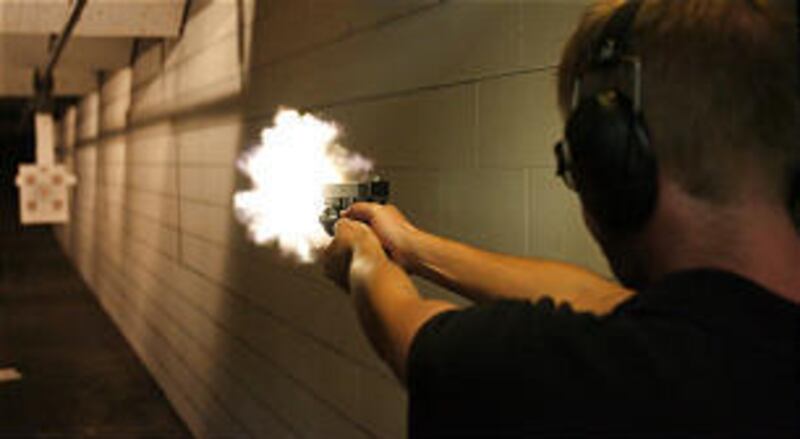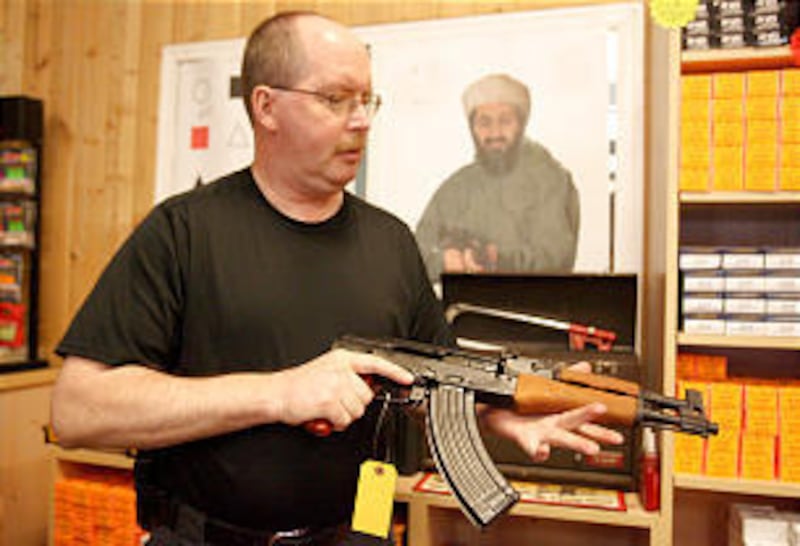With lightning-quick hands, the hero draws and shoots ... six times within a second and hits all six targets, the size of a dime.
Possible? In a movie. But out on the range, facing a small bull's-eye target 25 yards away, even with a steady hand and plenty of time to aim between rounds, it would be difficult for even the most skilled shooters.
Otherwise, it's not as easy as Hollywood makes it look, although it's not uncommon for a new shooter to show up, having seen such movies, and expect to see such accuracy.
Participation in shooting sports is increasing — a result of several things, which include the Olympics, the challenge involved and shooting tragedies such as the one at Trolley Square.
Following a shooting incident, anywhere in the country, people flood to the ranges, gun shops and classrooms offering concealed weapon permits.
"Then, over time, things start to taper off until the next incident," said Ken Collins, an owner in Range Masters of Utah, an indoor shooting range and gun shop in Springville.
Here in Utah, sport shooting, as elsewhere, is becoming more popular.
Collins attributes some of the growing interest to the fact that many of the people out West have grown up around firearms and feel more comfortable handling them.
"Also, a lot of people here in Utah like to hunt, and shooting is simply an extension of hunting. It allows them to use their guns and develop skills at the same time," he noted.
Sport shooting has been around since firearms were first invented. The aim, after all, was always to hit a target. Pistols came later and were made famous in the Old West where, as Sam Colt, inventor of the Colt revolver, always said: "God created men equal, Col. Colt made them equal."
Shooting events in the Olympics have also drawn attention to the sport. These events go back more than a century.
The rapid-fire pistol event was introduced into the Games in 1896, along with the free pistol event. Sport pistol and air pistol shooting came in 1984.
Nowadays, where packing a six-gun isn't the norm, there are two ways people can participate in sport shooting:
Driving to a remote location where shooting is legal.
Going to a local range.
There are 16 public and private shooting ranges listed in Utah.
The chosen distance for pistols at these ranges is 25 yards. Targets can be anything from bull's-eyes of varying sizes to silhouettes.
Twice a month — the first Wednesday and third Tuesday — Collins holds what he calls a "fun shoot." Targets of varying shapes and sizes are set up on the course, and one shooter at a time competes. Depending on the course and the targets, the shooter can be required to stand or move and shoot and, when necessary, reload.
The field of shooters coming to compete ranges from experts to beginners.
As for those interested in sport shooting, Collins said the best introduction anyone could get is to take a pistol course taught by an expert marksman. Collins teaches a one-on-one class consisting of five lessons, "but there are a lot of courses being taught in other places."
The first class covers the nomenclature of the handgun — its parts, different calibers and different models. The second class covers ammunition and the fundamentals of shooting. In classes three and four, students actually shoot a wide range of handguns of different calibers. In the final class there is a test and, if passed, a certificate. And, if the student has purchased a handgun at this point, Collins covers such things as cleaning the handgun and shooting. Otherwise, they stay with the guns he provides.
Cost of the class is $295, which covers one-on-one instruction, handguns, ammunition and range time.
"By the end of the class people have a good sense for safely interacting with a handgun. They are also informed enough by then to make a decision on what they want when buying their first handgun," he said.
"Without good instruction, people simply don't know how to properly handle a weapon. I see people doing a lot of unsafe things, like putting their finger on the trigger when they shouldn't and
pointing the handgun at other people."
This, too, is a time when basic firearm safety rules are instilled in the student:
1. All firearms are always considered to be loaded.
2. The muzzle must always be pointed down range and in a safe direction — never allow the muzzle to cover anything you are not willing to shoot.
3. Keep your finger off the trigger and out of the trigger guard, except when actually shooting at targets.
4. Be sure of where the bullet is going to end up.
In many cases people start out purchasing a .22 caliber handgun. It's easy to shoot, has little recoil and the ammunition is inexpensive.
As their skills grow, so does their sophistication with respect to handguns. That's when they either trade up to a larger caliber or a different handgun, which would include going from a revolver to a semiautomatic and vice versa.
One of the more popular models in the larger caliber handguns is the 9mm. Here again, it's an easy gun to shoot and it costs less to shoot than other models.
As far as a good age to start shooting, Collins said he recommends 10, "but even then that may be too young in some cases. I won't teach anyone younger than a teenager or a mature 12-year-old. It also depends on whether or not there is family involvement."
As far as developing shooting skills, Collins said the best way is for people to get involved in competitive shooting.
"It's controlled and it's held in a recreational environment. What we find, too, is that when people get into competitive shooting, they begin to pay more attention to their equipment and to how well they're shooting," he said.
There is a wide range of different disciplines in competitive shooting.
In the Olympics, for example, in air pistol the men shooters have an hour and 45 minutes to shoot 60 shots at a target 10 meters away. In rapid-fire pistol, competitors use a .22 caliber pistol and shoot five shots at a 10-ring target 4 inches wide. The three time limits for each five-shot series are eight, six and four seconds. And in sport pistol — a women's event — competitors use a .22 caliber pistol and shoot both precision and rapid-fire at a distance of 25 meters.
There are, of course, other events held at the different ranges. And, here again, the experience of the shooters goes from the very skilled to the newcomers.
And, as Collins pointed out, competitive shooting, or even just sport shooting, is a good way to improve shooting skills, have fun and learn to handle a handgun safely.
E-mail: grass@desnews.com



